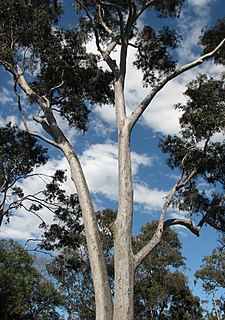
Corymbia maculata, commonly known as spotted gum, is a species of medium-sized to tall tree that is endemic to eastern Australia. It has smooth, mottled bark, lance-shaped to curved adult leaves, flower buds usually in groups of three, white flowers and urn-shaped or barrel-shaped fruit.

Eucalyptus propinqua, commonly known as the grey gum or small-fruited grey gum, is a species of medium-sized to tall tree that is endemic to eastern Australia. It has smooth, mottled bark, lance-shaped to curved adult leaves that are paler on the lower surface, flower buds in groups of between seven and fifteen, white flowers and conical or hemispherical fruit.

Eucalyptus blakelyi, known as Blakely's red gum, is a tree endemic to eastern Australia. It has smooth bark on its trunk and branches, dull bluish green, lance-shaped adult leaves, flower buds usually in groups of seven, white flowers and cup-shaped to hemispherical fruit.
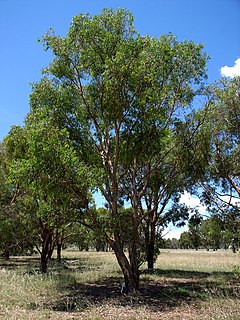
Eucalyptus parramattensis, commonly known as the Parramatta red gum or drooping red gum, is a species of small to medium-sized tree that is endemic to eastern New South Wales. It has smooth, mottled bark, lance-shaped to curved adult leaves, flower buds in groups of seven, white flowers and hemispherical fruit.
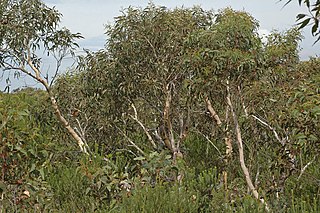
Eucalyptus racemosa, commonly known as snappy gum or narrow-leaved scribbly gum, is a species of small to medium-sized tree that is endemic to eastern Australia. It has smooth, mottled bark, lance-shaped to curved or egg-shaped adult leaves, flower buds in groups of between seven and fifteen, white flowers and cup-shaped, conical or hemispherical fruit.
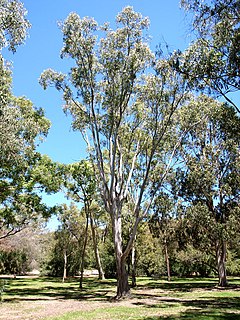
Eucalyptus amplifolia, commonly known as the cabbage gum, is a tree that is endemic to eastern Australia. It has smooth bark on its trunk and branches, lance-shaped leaves, and buds in groups of between seven and fifteen or more. The flowers are white and the fruit are woody hemispherical capsules. It is common on the coastal areas and tablelands of New South Wales and adjacent areas in south eastern Queensland, occurring as far south as Bega.

Eucalyptus dealbata, known as the tumbledown red gum or hill redgum, is a species of small tree that is endemic to eastern Australia. It has mostly smooth, white to grey or brownish bark, lance-shaped to egg-shaped adult leaves, flower buds in groups of between seven and eleven, white flowers and hemispherical fruit with the valves extended well beyond the rim of the fruit.
Eucalyptus conspicua, commonly known as Gippsland swamp-box, is a species of small tree that is endemic to southeastern Australia. It has rough, thick, fibrous bark from the trunk to its small branches, lance-shaped to curved adult leaves, flower buds in groups of seven, white flowers and conical or hemispherical fruit. The crown of the tree is composed of a dull bluish-green juvenile, intermediate and adult leaves.
Eucalyptus croajingolensis, commonly known as the East Gippsland peppermint or Gippsland peppermint, is a species of tree that is endemic to southeastern Australia. It has rough, short-fibrous bark on the trunk and larger branches, sometimes smooth bark on the thinner branches, lance-shaped to curved adult leaves, flower buds in groups of nine or more, white flowers and hemispherical to cup-shaped fruit.

Eucalyptus aquatica, commonly known as broad-leaved sally, or mountain swamp gum is a tree or mallee that is endemic to a small area of New South Wales in eastern Australia. It has smooth, greyish bark, dull bluish green adult leaves, flower buds arranged in groups of seven, white flowers and conical or hemispherical fruit. It grows in swamps and other places with poor drainage.
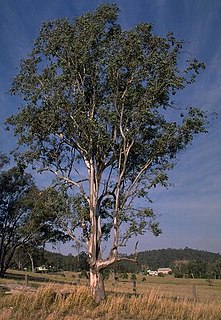
Eucalyptus glaucina, commonly known as the slaty red gum, is a species of small to medium-sized tree endemic to New South Wales. It has smooth, white and grey bark, lance-shaped adult leaves, flower buds in groups of seven, white flowers and hemispherical fruit with the valves protruding well above the level of the rim.
Eucalyptus interstans is a species of small to medium-sized tree endemic to New South Wales and Queensland. It has smooth white or greyish bark, lance-shaped or curved adult leaves, flower buds in groups of between seven and eleven, white flowers and cup-shaped to hemispherical fruit.

Eucalyptus nandewarica, commonly known as mallee red gum, is a species of tree or mallee that is endemic to a small area of western New South Wales. It has mostly smooth bark, lance-shaped adult leaves, flower buds in groups of three or seven, white flowers and cup-shaped or hemispherical fruit.
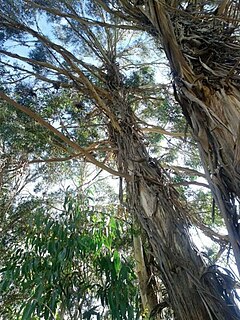
Eucalyptus nobilis, commonly known as ribbon gum or giant white gum, is a species of medium to tall tree that is native to northern New South Wales and south-east Queensland. It has a long, straight trunk with smooth, greyish bark that is shed in long ribbons, lance-shaped or curved adult leaves, flower buds in groups of seven, white flowers and cup-shaped or hemispherical fruit.
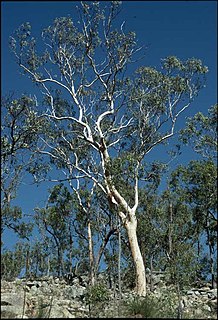
Eucalyptus pachycalyx, commonly known as the shiny-barked gum, is a species of tree that is endemic to north-eastern Australia. It has smooth, pale grey, mottled bark, lance-shaped or curved adult leaves, white flowers and cup-shaped or hemispherical fruit.

Eucalyptus fraseri, commonly known as Balladonia gum, is a species of tree or mallet that is endemic to Western Australia. It has smooth white to greyish bark, lance-shaped or curved adult leaves, flower buds in groups of seven or nine, white flowers and cup-shaped, conical or hemispherical fruit.
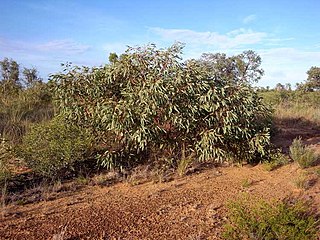
Eucalyptus ammophila, commonly known as the sandplain red gum, is a mallee that is endemic to central and southern Queensland. It has rough fibrous bark near the base and smooth greyish and orange to bronze bark higher up. It has lance-shaped leaves, yellow or creamy flower buds in groups of between seven and eleven, white flowers and hemispherical fruit with strongly raised valves.

Eucalyptus beaniana , commonly known as the Bean's ironbark, is a small tree that is endemic to Queensland. It has rough, furrowed "ironbark" on the trunk and branches, dull green to bluish, lance-shaped to curved adult leaves, flower buds in groups of seven, white flowers and cup-shaped to conical fruit. It is only known from four locations in southern inland Queensland.
Eucalyptus tardecidens is a species of mallee or small tree that is endemic to north Queensland. It has rough, fibrous or flaky bark on the trunk and branches, lance-shaped adult leaves, flower buds in groups of seven, white flowers and shortened oval to cylindrical fruit.
Eucalyptus lockyeri, commonly known as Lockyer's box, is a species of small tree endemic to a small area in Queensland. It has rough bark near the base of the trunk, smooth bark above, lance-shaped adult leaves, flower buds in groups of seven, white flowers and hemispherical fruit.
















